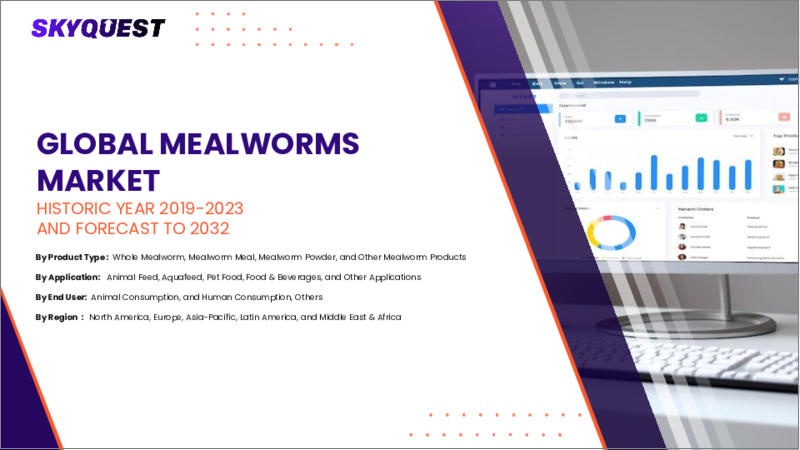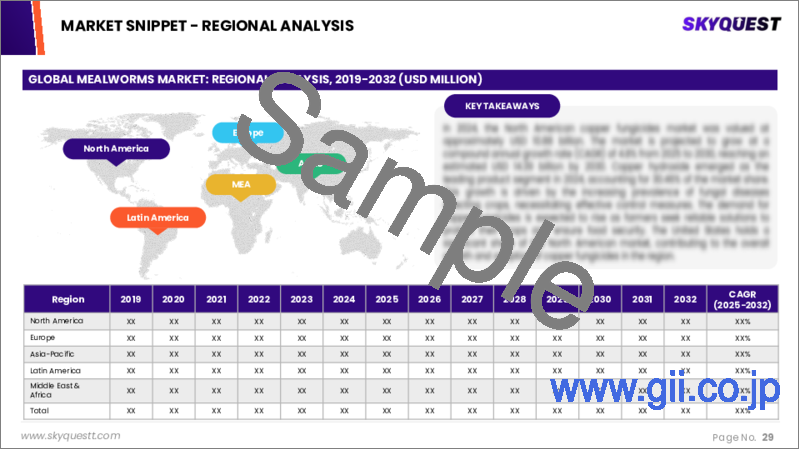|
|
市場調査レポート
商品コード
1633699
ミールワーム市場規模、シェア、成長分析、製品タイプ別、用途別、エンドユーザー別、地域別 - 2025~2032年産業予測Mealworms Market Size, Share, Growth Analysis, By Product Type (Live Mealworms, Dried Mealworms), By Application (Animal Feed, Pet Food), By End User, By Region - Industry Forecast 2025-2032 |
||||||
|
|||||||
| ミールワーム市場規模、シェア、成長分析、製品タイプ別、用途別、エンドユーザー別、地域別 - 2025~2032年産業予測 |
|
出版日: 2025年01月12日
発行: SkyQuest
ページ情報: 英文 325 Pages
納期: 3~5営業日
|
全表示
- 概要
- 目次
ミールワームの世界市場規模は、2023年に1億7,000万米ドルと評価され、2024年の2億1,000万米ドルから2032年には13億4,000万米ドルに成長し、予測期間(2025~2032年)のCAGRは25.8%で成長する見通しです。
COVID-19パンデミックは世界の産業、特に食品分野、特に食肉生産に大きな影響を与えました。ロックダウンや渡航制限が製造、流通、労働力の確保に支障をきたし、サプライ・チェーンに大きな課題をもたらしました。こうした困難から、消費者の関心は代替タンパク質、とりわけミールワーム・プロテインのような昆虫由来の製品に移っています。ミールワームの魅力は、その高い栄養価、従来の家畜に比べて少ない温室効果ガス排出量、人獣共通感染症のリスク低減にあります。しかし、昆虫の摂取による潜在的な副作用が市場成長の妨げになる可能性があります。パンデミック後の情勢が進展する中、代替タンパク質の台頭は消費者行動の重大な変化を浮き彫りにし、食品業界におけるイノベーションの新たな機会を提示しています。
目次
イントロダクション
- 調査の目的
- 調査範囲
- 定義
調査手法
- 情報調達
- 二次データと一次データの方法
- 市場規模予測
- 市場の前提条件と制限
エグゼクティブサマリー
- 世界市場の見通し
- 供給と需要の動向分析
- セグメント別機会分析
市場力学と見通し
- 市場概要
- 市場規模
- 市場力学
- 促進要因と機会
- 抑制要因と課題
- ポーターの分析
主な市場の考察
- 重要成功要因
- 競合の程度
- 主な投資機会
- 市場エコシステム
- 市場の魅力指数(2024年)
- PESTEL分析
- マクロ経済指標
- バリューチェーン分析
- 価格分析
ミールワーム市場規模:製品タイプ別とCAGR(2025-2032)
- 市場概要
- 生ミールワーム
- 乾燥ミールワーム
- ミールワームパウダー
- その他
ミールワーム市場規模:用途別とCAGR(2025-2032)
- 市場概要
- 動物飼料
- ペットフード
- 農業
ミールワーム市場規模:エンドユーザー別とCAGR(2025-2032)
- 市場概要
- 商業用
- 住宅用
ミールワーム市場規模とCAGR(2025-2032)
- 北米
- 米国
- カナダ
- 欧州
- ドイツ
- スペイン
- フランス
- 英国
- イタリア
- その他欧州地域
- アジア太平洋地域
- 中国
- インド
- 日本
- 韓国
- その他アジア太平洋地域
- ラテンアメリカ
- ブラジル
- その他ラテンアメリカ地域
- 中東・アフリカ
- GCC諸国
- 南アフリカ
- その他中東・アフリカ
競合情報
- 上位5社の比較
- 主要企業の市場ポジショニング(2024年)
- 主な市場企業が採用した戦略
- 市場の最近の動向
- 企業の市場シェア分析(2024年)
- 主要企業の企業プロファイル
- 会社概要
- 製品ポートフォリオ分析
- セグメント別シェア分析
- 収益の前年比比較(2022~2024年)
主要企業プロファイル
- Ynsect(France)
- Protix(Netherlands)
- NextProtein(France)
- Beta Hatch(USA)
- Entomo Farms(Canada)
- InnovaFeed(France)
- EnviroFlight(USA)
- AgriProtein(South Africa)
- Insectta(Singapore)
- Better Origin(UK)
- Mealworm Company(Netherlands)
- Kreca Ento-Food BV(Netherlands)
- Armstrong Crickets(Canada)
- Entobel(Vietnam)
- Protenga(Singapore)
- Hexafly(Ireland)
- Livin Farms(Austria)
- Tiny Farms(USA)
- Aspire Food Group(Canada)
- Nutrition Technologies(Singapore)
結論と推奨事項
Global Mealworms Market size was valued at USD 170 million in 2023 and is poised to grow from USD 210 million in 2024 to USD 1340 million by 2032, growing at a CAGR of 25.8% during the forecast period (2025-2032).
The COVID-19 pandemic has profoundly affected global industries, notably the food sector, particularly meat production. Lockdowns and travel restrictions disrupted manufacturing, distribution, and workforce availability, leading to significant supply chain challenges. These difficulties have shifted consumer interest toward alternative proteins, especially insect-based products like mealworm protein. The appeal of mealworms lies in their high nutritional value, lower greenhouse gas emissions compared to traditional livestock, and reduced risk of zoonotic diseases. However, potential adverse reactions to insect consumption may hinder market growth. As the landscape evolves post-pandemic, the rise of alternative proteins highlights a critical shift in consumer behavior and presents new opportunities for innovation within the food industry, suggesting a promising yet cautious future for mealworm protein products.
Top-down and bottom-up approaches were used to estimate and validate the size of the Global Mealworms market and to estimate the size of various other dependent submarkets. The research methodology used to estimate the market size includes the following details: The key players in the market were identified through secondary research, and their market shares in the respective regions were determined through primary and secondary research. This entire procedure includes the study of the annual and financial reports of the top market players and extensive interviews for key insights from industry leaders such as CEOs, VPs, directors, and marketing executives. All percentage shares split, and breakdowns were determined using secondary sources and verified through Primary sources. All possible parameters that affect the markets covered in this research study have been accounted for, viewed in extensive detail, verified through primary research, and analyzed to get the final quantitative and qualitative data.
Global Mealworms Market Segmental Analysis
Global Mealworms Market is segmented by Product Type, Application, End User and region. Based on Product Type, the market is segmented into Live Mealworms, Dried Mealworms, Mealworm Powder and Others. Based on Application, the market is segmented into Animal Feed, Pet Food and Agriculture. Based on End User, the market is segmented into Commercial and Residential. Based on region, the market is segmented into North America, Europe, Asia Pacific, Latin America and Middle East & Africa.
Driver of the Global Mealworms Market
The growth of the global mealworms market is primarily fueled by a variety of compelling factors that revolve around environmental and health benefits. The escalating greenhouse gas emissions associated with traditional livestock and poultry farming highlight the need for sustainable alternatives, with mealworms offering a nutritious and eco-friendly solution. Their high nutritional profile combined with significant environmental advantages encourages more consumers to incorporate edible mealworms into their diets. Additionally, the decreased risk of zoonotic diseases linked to insect consumption as opposed to conventional animal products further underscores mealworms' appeal. This burgeoning demand is also prompting increased investments from insect producers, especially in emerging economies.
Restraints in the Global Mealworms Market
The global mealworm market faces several restraints that may impede its growth potential. One major concern is the health risks linked to mealworm consumption, particularly the potential for allergic reactions, which could deter consumers and restrict market expansion. Furthermore, the COVID-19 pandemic has profoundly impacted the food industry, bringing numerous challenges to meat producers around the globe. These include ongoing risks related to production continuity, transportation, and distribution, as well as workforce shortages and disruptions in supply chains. Additionally, delays in development activities further exacerbate the difficulties faced by the mealworm market during this period.
Market Trends of the Global Mealworms Market
The Global Mealworms market is experiencing significant growth as health and wellness trends gain momentum, driven by rising health awareness and concerns over the risks associated with traditional animal proteins, including viral infections and chronic diseases. Consumers are increasingly seeking sustainable protein alternatives, positioning mealworms as a viable solution due to their nutritional benefits and environmentally friendly profile. In response, numerous vendors are investing in enhancing their production capacities, refining processing methods, and innovating product offerings to meet this demand. As a result, the mealworms market is poised for robust expansion, reflecting a shift towards more sustainable dietary practices and a focus on health-conscious eating.
Table of Contents
Introduction
- Objectives of the Study
- Scope of the Report
- Definitions
Research Methodology
- Information Procurement
- Secondary & Primary Data Methods
- Market Size Estimation
- Market Assumptions & Limitations
Executive Summary
- Global Market Outlook
- Supply & Demand Trend Analysis
- Segmental Opportunity Analysis
Market Dynamics & Outlook
- Market Overview
- Market Size
- Market Dynamics
- Drivers & Opportunities
- Restraints & Challenges
- Porters Analysis
- Competitive rivalry
- Threat of substitute
- Bargaining power of buyers
- Threat of new entrants
- Bargaining power of suppliers
Key Market Insights
- Key Success Factors
- Degree of Competition
- Top Investment Pockets
- Market Ecosystem
- Market Attractiveness Index, 2024
- PESTEL Analysis
- Macro-Economic Indicators
- Value Chain Analysis
- Pricing Analysis
Global Mealworms Market Size by Product Type & CAGR (2025-2032)
- Market Overview
- Live Mealworms
- Dried Mealworms
- Mealworm Powder
- Others
Global Mealworms Market Size by Application & CAGR (2025-2032)
- Market Overview
- Animal Feed
- Pet Food
- Agriculture
Global Mealworms Market Size by End User & CAGR (2025-2032)
- Market Overview
- Commercial
- Residential
Global Mealworms Market Size & CAGR (2025-2032)
- North America (Product Type, Application, End User)
- US
- Canada
- Europe (Product Type, Application, End User)
- Germany
- Spain
- France
- UK
- Italy
- Rest of Europe
- Asia Pacific (Product Type, Application, End User)
- China
- India
- Japan
- South Korea
- Rest of Asia-Pacific
- Latin America (Product Type, Application, End User)
- Brazil
- Rest of Latin America
- Middle East & Africa (Product Type, Application, End User)
- GCC Countries
- South Africa
- Rest of Middle East & Africa
Competitive Intelligence
- Top 5 Player Comparison
- Market Positioning of Key Players, 2024
- Strategies Adopted by Key Market Players
- Recent Developments in the Market
- Company Market Share Analysis, 2024
- Company Profiles of All Key Players
- Company Details
- Product Portfolio Analysis
- Company's Segmental Share Analysis
- Revenue Y-O-Y Comparison (2022-2024)
Key Company Profiles
- Ynsect (France)
- Company Overview
- Business Segment Overview
- Financial Updates
- Key Developments
- Protix (Netherlands)
- Company Overview
- Business Segment Overview
- Financial Updates
- Key Developments
- NextProtein (France)
- Company Overview
- Business Segment Overview
- Financial Updates
- Key Developments
- Beta Hatch (USA)
- Company Overview
- Business Segment Overview
- Financial Updates
- Key Developments
- Entomo Farms (Canada)
- Company Overview
- Business Segment Overview
- Financial Updates
- Key Developments
- InnovaFeed (France)
- Company Overview
- Business Segment Overview
- Financial Updates
- Key Developments
- EnviroFlight (USA)
- Company Overview
- Business Segment Overview
- Financial Updates
- Key Developments
- AgriProtein (South Africa)
- Company Overview
- Business Segment Overview
- Financial Updates
- Key Developments
- Insectta (Singapore)
- Company Overview
- Business Segment Overview
- Financial Updates
- Key Developments
- Better Origin (UK)
- Company Overview
- Business Segment Overview
- Financial Updates
- Key Developments
- Mealworm Company (Netherlands)
- Company Overview
- Business Segment Overview
- Financial Updates
- Key Developments
- Kreca Ento-Food BV (Netherlands)
- Company Overview
- Business Segment Overview
- Financial Updates
- Key Developments
- Armstrong Crickets (Canada)
- Company Overview
- Business Segment Overview
- Financial Updates
- Key Developments
- Entobel (Vietnam)
- Company Overview
- Business Segment Overview
- Financial Updates
- Key Developments
- Protenga (Singapore)
- Company Overview
- Business Segment Overview
- Financial Updates
- Key Developments
- Hexafly (Ireland)
- Company Overview
- Business Segment Overview
- Financial Updates
- Key Developments
- Livin Farms (Austria)
- Company Overview
- Business Segment Overview
- Financial Updates
- Key Developments
- Tiny Farms (USA)
- Company Overview
- Business Segment Overview
- Financial Updates
- Key Developments
- Aspire Food Group (Canada)
- Company Overview
- Business Segment Overview
- Financial Updates
- Key Developments
- Nutrition Technologies (Singapore)
- Company Overview
- Business Segment Overview
- Financial Updates
- Key Developments






